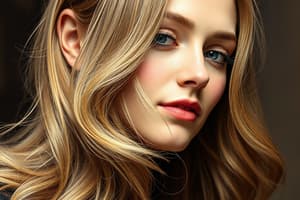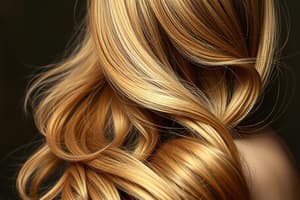Podcast
Questions and Answers
What is the pH range of permanent haircolor products?
What is the pH range of permanent haircolor products?
What happens to the cortex of the hair after processing with permanent haircolor?
What happens to the cortex of the hair after processing with permanent haircolor?
What occurs at the line of demarcation?
What occurs at the line of demarcation?
Which product is considered best for covering gray hair?
Which product is considered best for covering gray hair?
Signup and view all the answers
What are oxidation tints also known as?
What are oxidation tints also known as?
Signup and view all the answers
What is required before using oxidation tints?
What is required before using oxidation tints?
Signup and view all the answers
Which of the following is NOT a characteristic of oxidation tints?
Which of the following is NOT a characteristic of oxidation tints?
Signup and view all the answers
What must oxidation tints be mixed with to activate the oxidation process?
What must oxidation tints be mixed with to activate the oxidation process?
Signup and view all the answers
What happens to the hair's cuticle after processing with permanent haircolor?
What happens to the hair's cuticle after processing with permanent haircolor?
Signup and view all the answers
What marks the boundary between new hair growth and previously colored hair?
What marks the boundary between new hair growth and previously colored hair?
Signup and view all the answers
Why are oxidation tints significant in permanent haircoloring?
Why are oxidation tints significant in permanent haircoloring?
Signup and view all the answers
What do oxidation tints typically contain that requires a patch test before use?
What do oxidation tints typically contain that requires a patch test before use?
Signup and view all the answers
What is the pH range of permanent haircolor products?
What is the pH range of permanent haircolor products?
Signup and view all the answers
What additional characteristic do toners have in relation to oxidation tints?
What additional characteristic do toners have in relation to oxidation tints?
Signup and view all the answers
Which process immediately follows the hair dyeing procedure to restore pH balance?
Which process immediately follows the hair dyeing procedure to restore pH balance?
Signup and view all the answers
How do permanent haircolor products affect gray hair specifically?
How do permanent haircolor products affect gray hair specifically?
Signup and view all the answers
What happens as the hair dries after processing with permanent haircolor?
What happens as the hair dries after processing with permanent haircolor?
Signup and view all the answers
What indicates a need for a retouch application in haircoloring?
What indicates a need for a retouch application in haircoloring?
Signup and view all the answers
What characteristic of permanent haircolor aids in covering gray hair?
What characteristic of permanent haircolor aids in covering gray hair?
Signup and view all the answers
What is a common feature of oxidation tints?
What is a common feature of oxidation tints?
Signup and view all the answers
What makes toners different from other oxidation tints?
What makes toners different from other oxidation tints?
Signup and view all the answers
What is the general pH range of permanent haircolor products?
What is the general pH range of permanent haircolor products?
Signup and view all the answers
What is true about permanent haircolor after application?
What is true about permanent haircolor after application?
Signup and view all the answers
Which statement about haircolor application is correct?
Which statement about haircolor application is correct?
Signup and view all the answers
Study Notes
Permanent Haircolor Overview
- Permanent haircolor products have an alkaline nature, typically with a pH range of 9.0 to 10.5.
- Upon processing, hair is shampooed, and as it dries, it returns to its normal pH, causing the cortex to shrink and cuticle to close, trapping color molecules.
- Permanent haircolor does not wash out during shampooing, though it may fade over time and require refreshing.
- New hair growth creates a line of demarcation between previously colored and new hair, necessitating a retouch application.
Gray Hair Coverage
- Permanent haircolor is the preferred choice for effectively covering gray hair.
- It works by diffusing natural pigment through lifting and adding artificial color, resulting in a uniform blend of gray and non-gray areas.
Types of Permanent Haircolor
- Oxidation Tints: Known as aniline derivative tints or synthetic-organic tints, these can lighten and deposit color simultaneously and are available in a wide range of colors.
- Toners: A subset of oxidation tints, toners are aniline derivatives with pale shades intended for use on pre-lightened hair.
- Predisposition Test: Most oxidation tints necessitate a patch test before application to check for allergic reactions.
- Compatibility: When hair is healthy, oxidation tints can be safely used with other chemical services like waves and relaxers.
- Form of Application: Oxidation tints come in bottles, tubes, or canisters in semiliquid or cream forms and must be mixed with hydrogen peroxide to activate the oxidation reaction.
Permanent Haircolor Overview
- Permanent haircolor products have an alkaline nature, typically with a pH range of 9.0 to 10.5.
- Upon processing, hair is shampooed, and as it dries, it returns to its normal pH, causing the cortex to shrink and cuticle to close, trapping color molecules.
- Permanent haircolor does not wash out during shampooing, though it may fade over time and require refreshing.
- New hair growth creates a line of demarcation between previously colored and new hair, necessitating a retouch application.
Gray Hair Coverage
- Permanent haircolor is the preferred choice for effectively covering gray hair.
- It works by diffusing natural pigment through lifting and adding artificial color, resulting in a uniform blend of gray and non-gray areas.
Types of Permanent Haircolor
- Oxidation Tints: Known as aniline derivative tints or synthetic-organic tints, these can lighten and deposit color simultaneously and are available in a wide range of colors.
- Toners: A subset of oxidation tints, toners are aniline derivatives with pale shades intended for use on pre-lightened hair.
- Predisposition Test: Most oxidation tints necessitate a patch test before application to check for allergic reactions.
- Compatibility: When hair is healthy, oxidation tints can be safely used with other chemical services like waves and relaxers.
- Form of Application: Oxidation tints come in bottles, tubes, or canisters in semiliquid or cream forms and must be mixed with hydrogen peroxide to activate the oxidation reaction.
Permanent Haircolor Overview
- Permanent haircolor products have an alkaline nature, typically with a pH range of 9.0 to 10.5.
- Upon processing, hair is shampooed, and as it dries, it returns to its normal pH, causing the cortex to shrink and cuticle to close, trapping color molecules.
- Permanent haircolor does not wash out during shampooing, though it may fade over time and require refreshing.
- New hair growth creates a line of demarcation between previously colored and new hair, necessitating a retouch application.
Gray Hair Coverage
- Permanent haircolor is the preferred choice for effectively covering gray hair.
- It works by diffusing natural pigment through lifting and adding artificial color, resulting in a uniform blend of gray and non-gray areas.
Types of Permanent Haircolor
- Oxidation Tints: Known as aniline derivative tints or synthetic-organic tints, these can lighten and deposit color simultaneously and are available in a wide range of colors.
- Toners: A subset of oxidation tints, toners are aniline derivatives with pale shades intended for use on pre-lightened hair.
- Predisposition Test: Most oxidation tints necessitate a patch test before application to check for allergic reactions.
- Compatibility: When hair is healthy, oxidation tints can be safely used with other chemical services like waves and relaxers.
- Form of Application: Oxidation tints come in bottles, tubes, or canisters in semiliquid or cream forms and must be mixed with hydrogen peroxide to activate the oxidation reaction.
Studying That Suits You
Use AI to generate personalized quizzes and flashcards to suit your learning preferences.
Description
Test your knowledge on permanent haircolor and its chemical properties. Learn about the pH levels and the effects of coloring on hair structure. This quiz will dive deep into the processing and fading aspects of permanent haircolors.





